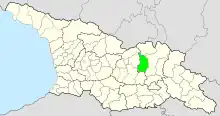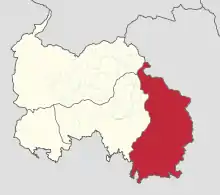Akhalgori Municipality
Akhalgori Municipality or Leningor District[2][3] (Georgian: ახალგორის მუნიციპალიტეტი, Ossetian: Ленингоры район, Russian: Ахалгорский муниципалитет) is a municipality in Georgia or South Ossetia[4] respectively. Georgia considers Akhalgori part of the Mtskheta-Mtianeti. According to Tskhinval, the current Head of Administration of Leningor is Alan Djussoev, and the current Deputy Head is Alexander Baratashvili.[5] Before the 2008 war, the municipality was divided, with the eastern part under Georgian and the western under South Ossetian control
Akhalgori Municipality
ახალგორის მუნიციპალიტეტი | |
|---|---|
District | |
.jpg.webp) | |
 Flag  Seal | |
  Location of Akhalgori Municipality | |
| Coordinates: 42°9′N 44°31′E | |
| Country | |
| De facto state | |
| Capital | Akhalgori |
| Government | |
| • De facto head of administration | Alan Djussoev |
| • Votes in Parliament | (of 69) |
| Area | |
| • Total | 1,011 km2 (390 sq mi) |
| Population (2002) | |
| • Total | 7,703 |
| • Density | 7.6/km2 (20/sq mi) |
| Time zone | UTC+3 (CET) |
| • Summer (DST) | UTC+4 (CEST) |
The Georgian controlled part of Akhalgori/Leningor Municipality had a population of 7,700 in 2002, with approximately 2,000 living in the town itself. The largest villages were Ikorta, Korinta, Qanchaveti, Kvemo Zakhori, Largvisi, Doretkari, and Karchokhi. The population was primarily Georgian (6,520) and Ossetian (1,110) prior to the 2008 Russo-Georgian War. Since the war, over 5,000 ethnic Georgians – at least 70% of the total population and 90% of local ethnic Georgians – have fled the area, citing discrimination and a "climate of fear" under the Russian-South Ossetian control. Unlike in other Georgian enclaves, Ossetian militias have not systematically destroyed village structures, though there have been some reports of attacks against civilians and complaints of intimidation.[6]
International status
According to administrative divisions of South Ossetia the municipality is located on territory of Leningor District.
Sites
The district houses several notable pieces of medieval Georgian architecture, listed below:
- Ikorta church
- Ikoti nunnery and church (1172)
- The monasteries of Kabeni, Largvisi, and Khopa (9th-13th century)
- The basilicas of Lomisi, Armazi, and Bikari;
- The fortresses of Tsirkoli and Tskhmori.[7]
- The old palace of the Eristavi noble Family
See also
Notes
References
- South Ossetia's status is disputed. It considers itself to be an independent state, but this is recognised by only a few other countries. The Georgian government and most of the world's other states consider South Ossetia de jure a part of Georgia's territory.
- Toal, Gerard (2017). Near Abroad: Putin, the West, and the Contest Over Ukraine and the Caucasus. Oxford University Press. ISBN 978-0-19-025330-1.
- Daily Report: Soviet Union. The Service. 1991.
- Hewitt, B. George (2013-03-21). Discordant Neighbours: A Reassessment of the Georgian-Abkhazian and Georgian-South Ossetian Conflicts. BRILL. ISBN 978-90-04-24893-9.
- "New administration of Leningor district appointed". 20 August 2009.
- Georgia-Russia: Still Insecure and Dangerous Archived 2009-08-06 at the Wayback Machine, p. 7. International Crisis Group Europe Briefing N°53. 22 June 2009
- "Georgia - ICOMOS World Report on Monuments and Sites in Danger 2001: Heritage @ Risk".